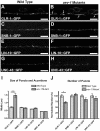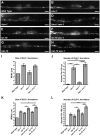UEV-1 is an ubiquitin-conjugating enzyme variant that regulates glutamate receptor trafficking in C. elegans neurons
- PMID: 21179194
- PMCID: PMC3001443
- DOI: 10.1371/journal.pone.0014291
UEV-1 is an ubiquitin-conjugating enzyme variant that regulates glutamate receptor trafficking in C. elegans neurons
Abstract
The regulation of AMPA-type glutamate receptor (AMPAR) membrane trafficking is a key mechanism by which neurons regulate synaptic strength and plasticity. AMPAR trafficking is modulated through a combination of receptor phosphorylation, ubiquitination, endocytosis, and recycling, yet the factors that mediate these processes are just beginning to be uncovered. Here we identify the ubiquitin-conjugating enzyme variant UEV-1 as a regulator of AMPAR trafficking in vivo. We identified mutations in uev-1 in a genetic screen for mutants with altered trafficking of the AMPAR subunit GLR-1 in C. elegans interneurons. Loss of uev-1 activity results in the accumulation of GLR-1 in elongated accretions in neuron cell bodies and along the ventral cord neurites. Mutants also have a corresponding behavioral defect--a decrease in spontaneous reversals in locomotion--consistent with diminished GLR-1 function. The localization of other synaptic proteins in uev-1-mutant interneurons appears normal, indicating that the GLR-1 trafficking defects are not due to gross deficiencies in synapse formation or overall protein trafficking. We provide evidence that GLR-1 accumulates at RAB-10-containing endosomes in uev-1 mutants, and that receptors arrive at these endosomes independent of clathrin-mediated endocytosis. UEV-1 homologs in other species bind to the ubiquitin-conjugating enzyme Ubc13 to create K63-linked polyubiquitin chains on substrate proteins. We find that whereas UEV-1 can interact with C. elegans UBC-13, global levels of K63-linked ubiquitination throughout nematodes appear to be unaffected in uev-1 mutants, even though UEV-1 is broadly expressed in most tissues. Nevertheless, ubc-13 mutants are similar in phenotype to uev-1 mutants, suggesting that the two proteins do work together to regulate GLR-1 trafficking. Our results suggest that UEV-1 could regulate a small subset of K63-linked ubiquitination events in nematodes, at least one of which is critical in regulating GLR-1 trafficking.
Conflict of interest statement
Figures










References
-
- Dingledine R, Borges K, Bowie D, Traynelis SF. The glutamate receptor ion channels. Pharmacol Rev. 1999;51:7–61. - PubMed
-
- Malenka RC, Bear MF. LTP and LTD: an embarrassment of riches. Neuron. 2004;44:5–21. - PubMed
-
- Malenka RC. Synaptic plasticity and AMPA receptor trafficking. Ann N Y Acad Sci. 2003;1003:1–11. - PubMed
-
- Shepherd JD, Huganir RL. The cell biology of synaptic plasticity: AMPA receptor trafficking. Annu Rev Cell Dev Biol. 2007;23:613–643. - PubMed
Publication types
MeSH terms
Substances
Grants and funding
LinkOut - more resources
Full Text Sources
Molecular Biology Databases
Research Materials

